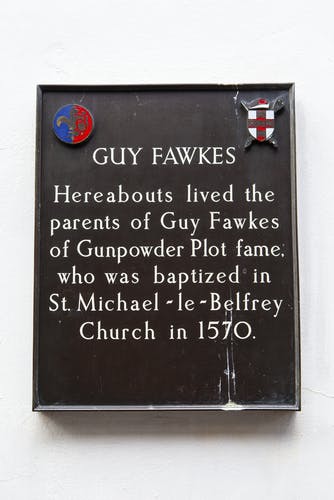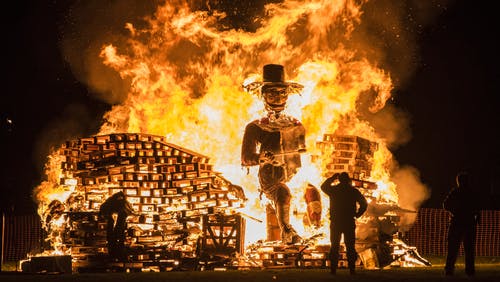It’s November, which means it’s almost time for Guy Fawkes Night (also known as Bonfire Night) in the UK. A night when people brave the November cold and celebrate with fireworks and large bonfires. But why do they celebrate like this on such an arbitrary date? We’re going to delve into the colourful, weird and somewhat gruesome history and traditions of Guy Fawkes night in Britain.
First a Little History

The festivity is immortalised by by the annual bonfires and fireworks and the short rhyme: “Remember, remember the 5th November. Gunpowder, treason and plots. I see no reason why gunpowder treason should ever be forgot!” sums up its origins very nicely. The first Guy Fawkes Night was celebrated on November 5th 1605, the day of the titular Guy Fawkes arrest. Who was Guy Fawkes I hear you ask?
Guido (or Guy) Fawkes was born in Yorkshire in 1570. When he was eight years old his father died and his mother later married a practising Catholic who may or may not have contributed to the young Guy converting to the religion himself. He later joined the fighting in the Eighty Years War on the side of the Spanish. While in Spain he tried to raise support for a rebellion in his home land to raise a Catholic monarch to the throne with little success. After returning to England he then joined the plot he is now most famous for, to assassinate the protestant King James I with explosives and replacing him with a Catholic successor. After being caught red handed with several barrels of gunpowder in the cellars under Parliament (where the King would be visiting the next day) he confessed to the plot and then under torture revealed the names of the other conspirators. He and the rest of the plotters were later executed publicly for high treason by being hung, drawn and quartered.
The monarchy after capturing Fawkes and foiling the plot encouraged the public to mark the occasion with celebratory bonfires and an act of Parliament later made the festivity official.
Where is it Celebrated

Whilst attempts were made to export the holiday to other Crown territories in the days of the British Empire (including America) the holiday has never been as popular as it has been in the UK. However, you’ve probably seen Guy Fawkes face around more recently as masks of his image became a popular due to its use in the Hollywood blockbuster V for Vendetta and in the Occupy and the Anonymous online movement during the economic crash of 2008. His image continues to be a symbol of resistance to authority even to this day.
How do Brits Celebrate it Today

Guy Fawkes night today is quite different from the simpler celebrations of the 1600s. Since the 19th Century it has been a much more organised and larger event in general with local fetes being set up across the country. Obviously the introduction of commercial fireworks has allowed the night to take on a much more spectacular edge. It is not however a national bank holiday with business remaining open and people going about their activities as normal but there are always large organised fireworks displays either on Bonfire night itself or on the closest weekend day.
The original anti-Catholic sentiment of the original celebration has been thankfully been long discarded with many enjoying the opportunity to brighten up the cold November night with colourful fireworks and the warmth of the bonfires. Another of the rather bizarre original traditions was to construct effigies of Guy Fawkes himself and to throw them on the bonfires but over time this is becoming a less integral part of the night. In fact some now use the night as an opportunity to cremate images of modern political figures who fall foul of local public opinion.
For many the it is just another day but in cities across the UK, they will always remember the 5th November.
If you want to celebrate by sending flowers to the UK with FloraQueen we have everything you need to make it happen. Choose from a wide catalogue of bouquets and take advantage of international delivery to cities all across the UK.
